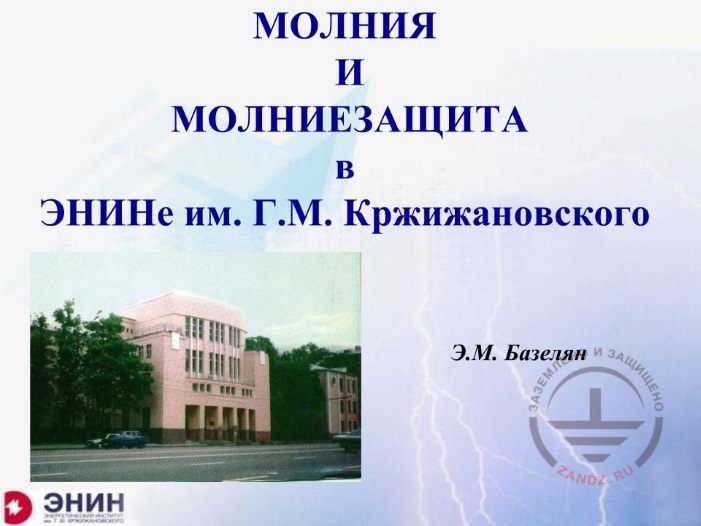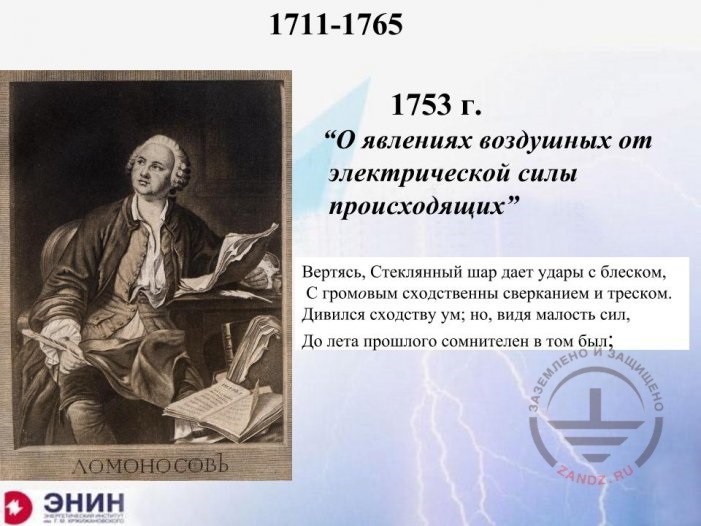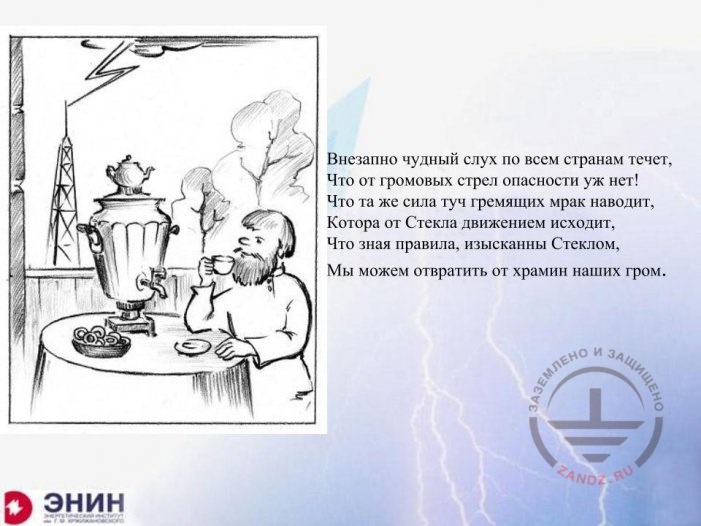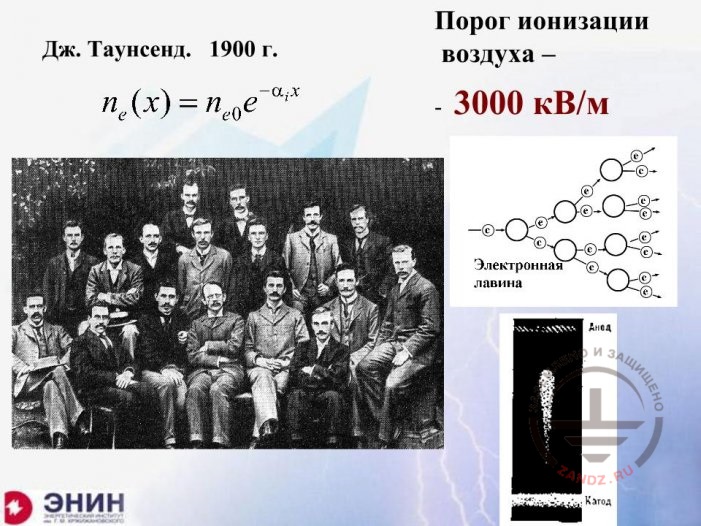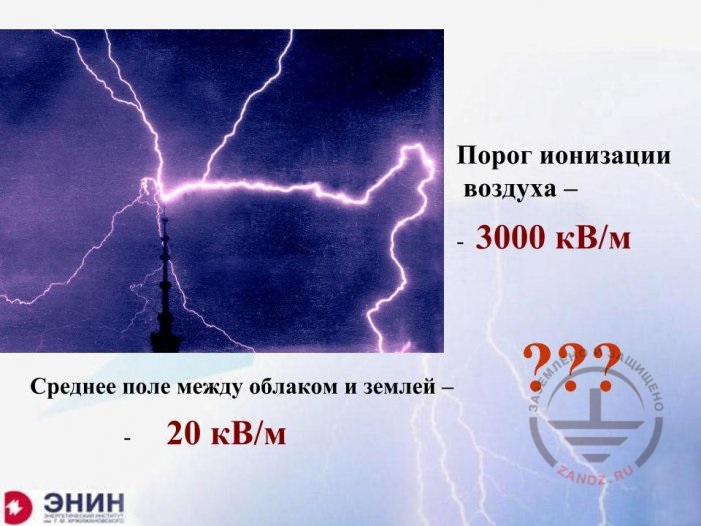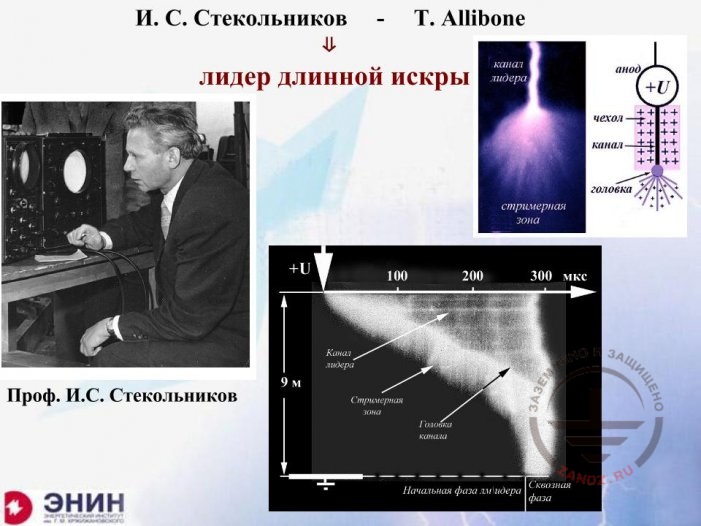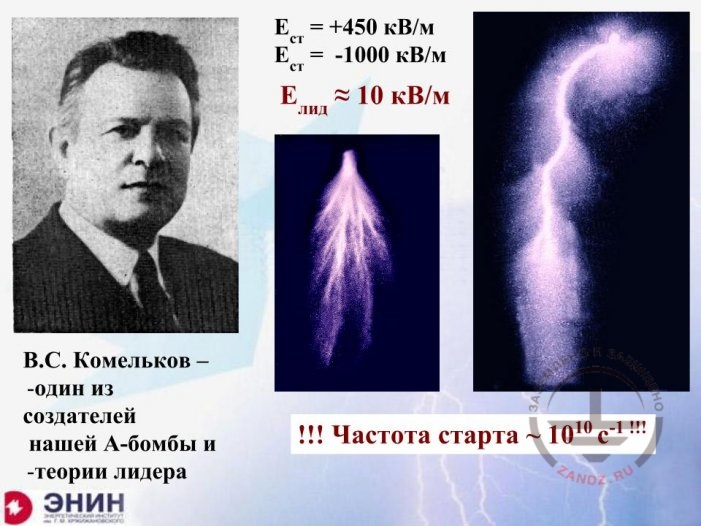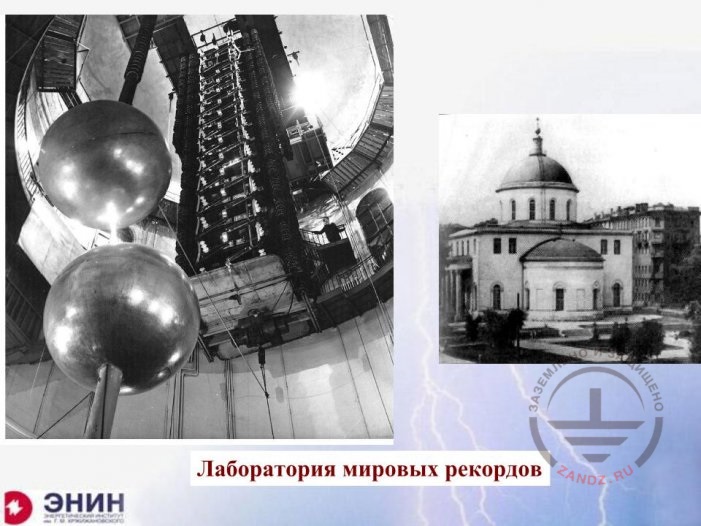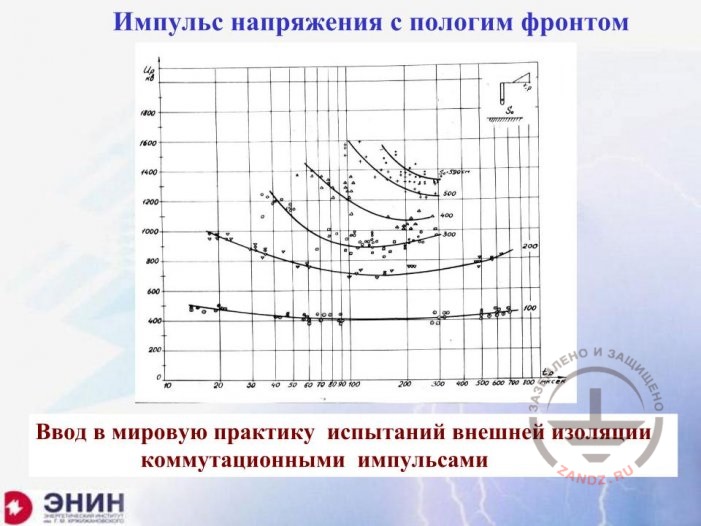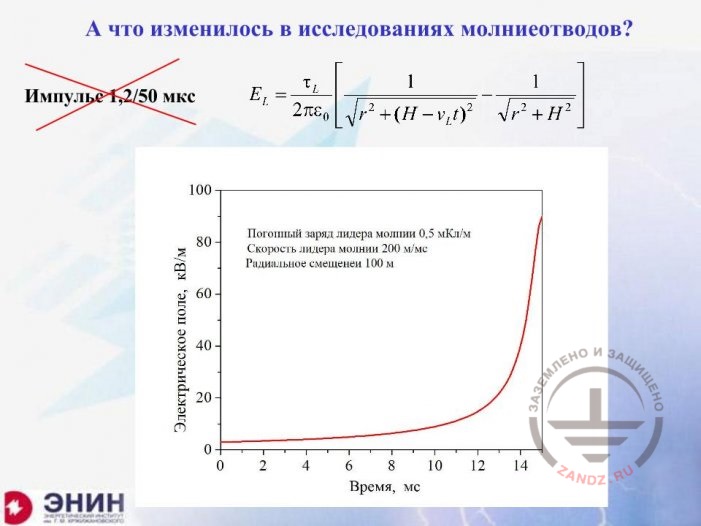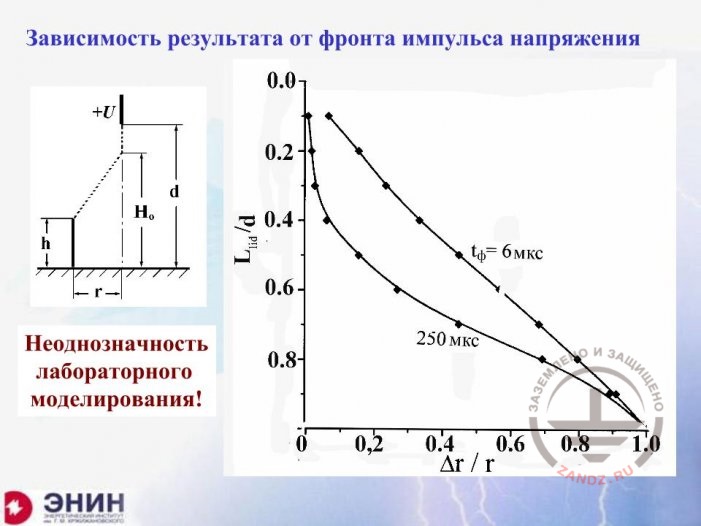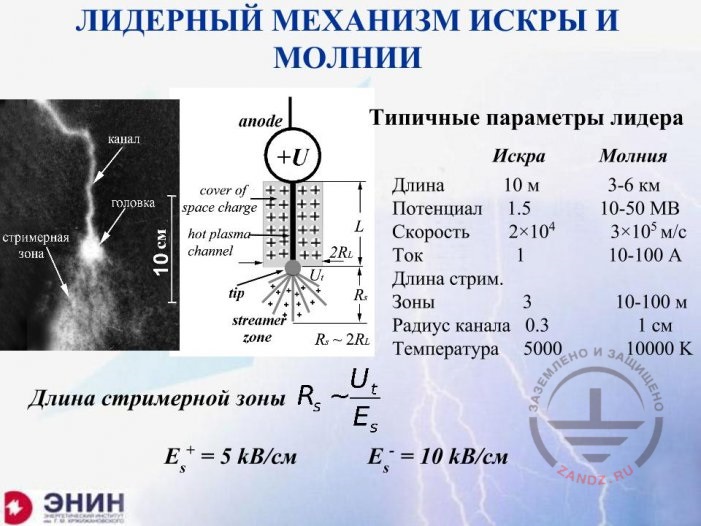The twelfth event from the series "Grounding and lightning protection: questions and problems arising in the design"
(The video lecture was held on January 20, 2016)
Full-screen mode with the quality of "720p" is recommended.
The first studies of lightning and the development of protection methods began more than 250 years ago. Despite this, modern lightning protection still has many questions that have not been answered.
Eduard Meerovich shared the information about the history of lightning protection development in Russia and in the world, interesting facts from this history, unique experiments with lightning, world records in physics, and also he told about the types of modern lightning protection systems and how they work. The video lecture has an informational nature and will be interesting and useful for designers, electrical engineers, research workers, students of technical departments and anyone who is somehow connected with lightning protection and grounding.
Navigation through the video lecture:
- The first scientific study of lightning, timecode 00:03:02
- (Middle of XVIII th century, studies by Benjamin Franklin and the feedback of Mikhail Lomonosov to these studies)
- The beginning of studies on the physics of long sparks, timecode 00:06:10
- (late IXXth - early XXth century, the theory of avalanches by John Sealy Edward Townsend; the question of how the long spark channel had been developing from the cloud to the ground.)
- Studies of long spark physics in the USSR, timecode 00:07:55
- (1930s, Gleb Krzhizhanovsky initiated the study of long spark physics; research by Ilya Samuilovich Stekolnikov, the discovery of the long spark leader)
- Experiments by Vadim Komelkov, timecode 00:12:51
- (Long spark studies, an unexpected business trip)
- Work of the laboratory during war and after the war, timecode 00:17:52
- (Lightning research during the World War II and after it; the creation of a surge overvoltage generator for 3 000 000 V; the era of the world records, the creation of a pulse oscillograph, the development of non-inductive cylindrical shunts, the pursuit of the most perfect records of the current leader; the creation of a Russian electronic-optical converter)
- The activities of the laboratory during the late 1950s - 1960s, timecode 00:24:02
- (the period when Eduard Bazelyan joined Kzhyzhanovsky Institute, a new level of the laboratory's operations, lightning simulation, studying the dependence of the result on the voltage pulse front)
- The leader mechanism of a spark and lightning, timecode 00:35:35
- About the role of the streamer zone and the case of a space charge, timecode 00:37:02
- The elementary leader theory, timecode 00:38:58
- The history of appearing of the Russian protection zones, timecode 00:40:05
- Lightning path, timecode 00:42:17
- (which way will the lightning strike take - a short or a long one? Development of the statistical method by Krzhyzhanovsky's Institute (Electrical Institute)
- The methodical basis of the calculation of the number of lightning strikes into overhead lines, timecode 00:45:41
- Registration of the lightning strikes to the Ostankino TV tower, timecode 00:47:06
- Possibilities of the Krzhyzhanovsky's Institute (Electrical Institute) statistical method and its application, timecode 00:48:23
- Studies of the lightning corona by Valery Popkov, timecode 00:52:14
- "Triggered lightning" experiment, timecode 00:55:33
- (about the charge cloud)
- Study of the corona discharge in an electric field of a thundercloud, timecode 00:55:33
- The application of corona discharge studies, timecode 1:01:10
- (about dissipation array systems that prevent the formation of a counter-leader and, consequently, a direct lightning strike to a facility)
- What active lightning protection actually does, timecode 1:06:50
- Lightning protection grounding, timecode 1:10:39
- (about electrical fields and the behavior of the lightning current in the ground)
- Collaboration between Krzhyzhanovsky's Institute, High Temperatures Institute of RAS and RF SRC TRINITY, timecode 01:14:07
- (About the creation of a surge generator with a voltage of 2 mV and an energy of 4 MJ, as well as studies carried out using this generator)
- Closing words, timecode 1:19:08
- (Conference on lightning protection, regulatory documents and important tasks of lightning protection, well-wishing to the younger generation of researchers)
Webinar text. Page 1
Quick navigation through slides:
Page 1:
1. Lightning and lightning protection at Krzhizhanovsky Power Engineering Institute
2. Statement of M.V.Lomonosov about lightning
3. Message of Franklin to count Shuvalov
4. The theory of J.Townsend
5. Air ionization threshold
6. Professor I.S. Stekolnikov’s work
7. Experiments of V.S. Komelkov
8. Laboratory of world records
9. Voltage pulse with a low angle front
10. What changed in the researches of lightning rods?
11. Dependence of the result on the voltage front pulse
12. Leader mechanism of spark and lightning
13. Why do long spark and lightning need a complex structure?
14. Role of streamer zone and spacial charge casing
15. Elementary theory of a leader
16. Theory extrapolation
17. Russian protection zones – where do they come from?
18. Research photos
19. Lightning path
20. ENIN statistical theory
21. Methodological base for calculation of the number of lightning strikes into the high-voltage power lines
22. Possibilities of a statistical method
23. Operating voltage impact
24. Impact of forest along the high-voltage power line route
25. David and Goliath (gas discharge version)
26. Corona and lightning
27. Streamer flash start
28. Gold’s hypothesis
29. Practical implementation
30. Catenary wire lightning rods for the protection of switchyard substations
31. Expected results
32. ESE lightning rods – myth not a reality
33. Danger of spak channels long the ground surface
34. Experiment in Sarov
35. United field tests by ENIN, OIV RAN, TINITI
36. Where else science is required
Estimated reading time: 60 minutes
Lightning and lightning protection at Krzhizhanovsky Power Engineering Institute
| МОЛНИЯ И МОЛНИЕЗАЩИТА в ЭНИНе им. Г.М. Кржижановского | LIGHTNING AND LIGHTNING PROTECTION in the G.M. Krzhizhanovsky ENIN |
| Э.М. Базелян | E.M. Bazelyan |
– Good afternoon, dear colleagues. Several months ago, the administrators of our webinars offered me to tell you about the practice of lightning protection adopted in our Institute. I agreed thoughtlessly and started to prepare for this webinar. And then I saw that it did not work out. It does not matter how much time I spent for the good presentation, it just turned out to be awful. After many tries, I realized that the point is not me but rather the task I was set because we cannot consider the Institute's practice apart from the scientific activity. All our practice was based on the scientific developments of the Institute. And I could only tell you about the practice if it was with regards to our laboratory. And when I said that to the administrators, they answered: "OK. Try to do this way!" And I tried. You are to judge on the result but I need to say that although I have been working in the laboratory for over 50 years and I have been through all the milestones in its work, including the practical aspects, I am a participant of this work. It means that I had my own view of this, which is certainly biased. And my story is also biased. I want to make a reservation that I am an employee of the laboratory. Although I am a very old employee that has worked for more than 50 years and participated in many scientific and practical developments, I am still its participant. It means that this is my personal opinion. And therefore, the report you are going to listen to will also be biased to some extent. And I ask apologies for that. I will not be able to do it differently. Now, a question may be asked. What lightning protection science can we talk about if two and a half centuries ago, Benjamin Franklin proved that lightning and sparks are almost the same?
M.V. Lomonosov's statement about lightning
| 1753 г. | 1753 |
| «О явлениях воздушных от электрической силы происходящих» | “On air phenomena resulting from the electrical power” |
| Вертясь, Стеклянный шар дает удары с блеском, С громовым сходственны сверканием и треском. Дивился сходству ум; но, видя малость сил, До лета прошлого сомнителен в том был; |
When it turns, the Glass sphere strikes and flashes, Which is similar to the thunder. And my mind was intrigued with this similarity, but I did not see enough power, So I was in doubt until the last summer |
– And first, Mikhail Lomonosov who was excited with the Franklin's articles wrote the following:
"When it turns, the Glass sphere strikes and flashes,
Which is similar to the thunder.
And my mind was intrigued with this similarity, but I did not see enough power,
So I was in doubt until the last summer".
Look at how Lomonosov approached the concepts of spark and lightning. He could see that the scales were different and that scale-up is required in this case. For this reason, he wrote a series of articles about scale-up.
Franklin's message to count Shuvalov
| Внезапно чудный слух по всем странам течет, Что от громовых стрел опасности уж нет! Что та же сила туч гремящих мрак наводит, Которая от Стекла движением исходит, Что зная правила, изысканны Стеклом, Мы можем отвратить от храмин наших гром. |
Surprisingly, wonderful words have spread across the countries, That there is no more danger from the thunder arrows! That it is the same power that threatens in the clouds, Which is caused by the Glass as it moves, That if we know the rules provided by the Glass, We can take away the thunder from our houses. |
– And finally, when Franklin conducted his final experiments, survived, and obtained a long spark from the conductive silk fiber, he said the following words in his message addressed to Count Shuvalov:
"Surprisingly, wonderful words have spread across the countries,
That there is no more danger from the thunder arrows!
That it is the same power that threatens in the clouds,
Which is caused by the Glass as it moves,
That if we know the rules provided by the Glass,
We can take away the thunder from our houses."
It looks like everything has been formulated. We may take the lightning away from our houses, but two and a half centuries the research have been conducted, and they have not yet led to the unambiguous methods of lightning protection, unambiguous trends and unambiguous rules for protection from the thunder and the lightning.
J. Townsend theory
| Дж. Таунсенд. 1900 г | J. Townsend. 1900 |
| Порог ионизации воздуха - | Air ionization threshold |
| - 3000 кВ/м | - 3,000 kV/m |
| Электронная лавина | Electronic avalanche |
– What did it begin with? It began with the long spark physics in the beginning of the 20th century when an Englishman Townsend created his avalanche theory and showed that the non-conductive air turns into the conductive spark due to the avalanche-like reproduction of electrons. However, according to the experiments conducted by Townsend for this purpose, a significant electrical field is required for this. The electrical field of about 3 million V/m. But such field never existed between the cloud and the earth.
Air ionization threshold
| Порог ионизации воздуха - | Air ionization threshold |
| - 3000 кВ/м | - 3,000 kV/m |
| Среднее поле между облаком и землей - | Average field between the cloud and the earth - |
| - 20 кВ/м | - 20 kV/m |
– There was a cloud, for example, 20 kV/m or 30 kV/m, but not 3,000 kV/m as Townsend needed, between the cloud and the earth. And further research led to the need to understand how the long spark channel, and a lightning is an extra-long spark, developed from the cloud to the earth. We had a scientific gap here. And many researches tried to close this gap, including the ones conducted by the initiative of our Krzhizhanovsky Institute, by the author of the GOELRO project, which were started in the beginning of 1930s.
I.S. Stekolnikov's study
| И. С. Стекольников | I.S. Stekolnikov |
| Лидер длинной искры | Long spark leader |
| Анод | Anode |
| Чехол | Enclosure |
| Канал | Channel |
| Головка | Head |
| Проф. И.С. Стекольников | Prof. I.S. Stekolnikov |
| Мкс | mcs |
| Начальная фаза лидера | Initial leader phase |
| Сквозная фаза | Through phase |
| Канал лидера | Leader channel |
| Стримерная зона | Streamer zone |
| Головка канала | Channel head |
—– These works were guided by a young scientist. He was only 31 then. Ilya Stekolnikov. By that time, Stekolnikov has managed to graduate from the Power Faculty of the Moscow Higher Technical College, has had the internship in England and Germany, where very serious research dedicated to long sparks conducted. He mastered the experimental technique of that time and could discover the phenomenon that nobody observed before him. He saw a long spark channel in the laboratory. He called this channel a trace after the lightning channel, a leader of a long spark, and started a heavy struggle for the priority with an English specialist Allibone, who did the same using the same methods and equipment at same time. This struggle took about 30 years. It was completely unreconcilable at that time. It was ongoing when I joined the laboratory. It was Allibone who gave up, not Stekolnikov. In his milestone lecture he said, that this phenomenon was discovered by Ilya Stekolnikov in the USSR using the same methods and the same device, and that their works were completely independent. And he confirmed the authority and the priority of Stekolnikov as much as he acknowledges Allibone’s. It was like this. By the end of 1970s, Allibon could visit the Soviet Union. But he could not see Stekolnikov because he died in 1969. He met us, his students. We talked about all this work. And they were included in the classical studies of the long spark lightning.
You can see Stekolnikov here, on this photo.
Experiments of V.S. Komelkov
| кВ/м | kV/m |
| В.С. Комельков – один из создателей нашей А-бомбы и теории лидера | V.S. Komelkov is one of the developers of the Russian atomic bomb and a leader theory |
| !!! Частота старта ~ 1010 с-1!!! | !!! Start frequency ~ 1010 s-1!!! |
– Vladimir Komelkov was a researcher of another kind. All Stekolnikov's experiments were aimed at the world records. But Vladimir Komelkov, although he was a vivid and energetic person, had different aims during the experiments. He wanted to understand the essence of phenomena he observed. He studied that the channel of a long spark is a highly conductive formation, almost an arc channel. Komelkov rapidly measured and showed that it is an arc channel in terms of conductivity. But before this channel, a bunch of long branches is formed, which were called streamers. They are low-conductive and require the fields of several kilovolts per 1 cm of their length. And such fields, the streamers, start all the time surrounding the channel with an enclosure. Komelkov understood that between this main arc channel, the leader and streamer channels, some relationship exists. He moved fast when searching for it, but in 1947 or 1948, his experiments stopped forever. It happened for the following reason. He met a groupmate in the street and he asked: "What do you do?" And the groupmate said that he worked outside of Moscow, in another town, some "box". Nearly everyone worked in "boxes" then. Komelkov asked what they did in this "box". "We are trying to synchronize several phenomena in a microsecond range so that they would coincide with an accuracy of up to several fractions of a microsecond". Komelkov laughed:
Komelkov returned to Moscow with lots of orders, laureate medals, and high position in an organization that is called Rosatom today. He tried to avoid the bureaucratic work, then he returned to our Institute and never ever worked on the theory of a long spark. I think it was a significant loss for the long spark and lightning theory, although Komelkov's contribution to the creation of the Russian nuclear weapon was important. In any case, you may find and read a book of memories of the nearest coworkers of Kurchatov, and Komelkov was among them. It is a very interesting book. Komelkov wrote an interesting chapter in this book. But, unfortunately, Komelkov never returned to the long spark. What happened in the laboratory? The laboratory did not stop its work even for a moment. The field research of the lightning had started before the war in the Caucasus Mountains, and the entire laboratory took part in it. When the Great Patriotic War began, the research were not stopped. I want to show you the book published by the Academy of Sciences. It is titled "Lightning Physics and Storm Protection". It was published in 1943. In 1943, the victory over Germany was not close. It was a hard time but the research continued.
Laboratory of world records
| Лаборатория мировых рекордов | Laboratory of world records |
– Immediately after the end of the war, the laboratory received a task near the Nikitskiye Gates. It was a Church of the Great Ascension. According to the legend, Pushkin and Natalya Goncharova got married there. But in fact, they got married in a different church. This church was built in 1858, and the marriage was in 1832, as you remember. But the church was built like many other Russian churches. An old church that stood there and where Natalya Goncharova and Pushkin got actually married, became one of its chapels. And in this church that is 36 meters high, a pulse voltage generator for 3 million volts was constructed from the Russian materials. This generator was installed upside down. It was installed not on the earth but its earthed end was installed underneath the church dome. And the entire generator was lowered down to the height of about 11 meters above the ground level and allowed to conduct experiments in this building, which were of the world-class level then. The end of the 1950s was a period of world records in the laboratory of high-voltage discharges of the Krzhizhanovsky Energy Institute. You know, each experiment of that time was literally an experiment that claimed for the record into the Guiness Book of World Records. Young Alexander Yankov made a modern pulse oscillograph on the basis of the first Russian electron-beam (double-beam) tube, which allowed for the recording of fractions of a microsecond and using this oscillograph during the long spark recording. Concurrently, the laboratory studied the non-inductive cylindrical shunts and the search for the perfect records of the leader current was started by a single woman working with a long spark, Inna Pulavskaya. She is still alive. At that time, she was young and beautiful. The journalists that came to the laboratory started their stories with the following words: "A slim girl drumming with her heels on the floor, approached... (and further according to the text)". We even tweaked her for these words. At that time, Evgeny Braga, No. 1 in the well-known group of eight called "Soviet Wings" that won the Heinlein regatta at that time and that was filmed in the movie that is still famous, "Royal Regatta", made the first Russian electron-optical converter with a continuous image scan. After some time, it will be a converter with the light enhancer that allowed for the results that could not be achieved by anyone else in the world. It was another flow of world records. And the situation was as follows.
He engaged the most experienced researcher of that time, Evgeny Braga, so that Braga would do this work for him. Braga considered such work to be beneath his dignity, and he had reasons for that, so he called the most low-skilled person in the laboratory, and it was me. By that time, I had made a lot of mistakes in the laboratory, and therefore Braga noted: "Will you be able to do at least such a simple thing?" And I tried to do it. We supposed that in the 3-meter long gap to be studied, the electrical strength should be around 1.5 million volts. We made a circuit, set up the oscillographic records, received oscillograms. We interpreted them the next day and saw that it was less than a million. I spit out an oath and went to the laboratory to repeat. After that I obtained the same value and went to Braga apologetically. He took me by the collar as he was a big man. And said: "Let's go, I will teach you how to measure". He measured and obtained the same 12 kV. And after that, the rush job started in the laboratory. We worked days and nights. By the beginning of 1960, an article was sent to the journal "Reports of the Academy of Sciences", which was almost like the European "Nature" then. And the article said that within the range of several hundreds of microseconds, the electrical strength of the air is dramatically reduced, and it occurs the stronger, the longer the gap wherein such measurements are made.
Voltage pulse with a low-angle front
| Импульс напряжения с пологим фронтом | Voltage pulse with a shallow front |
| Ввод в мировую практику испытаний внешней изоляции коммутационными импульсами | Implementation of external insulation by commutation pulses in the world practice |
– Around such curves shown in the slide here, another work of a higher level began in the equipment. But we will be primarily interested in the following. How does it relate to the lightning protection? The fact that it is significant for the insulation research can be understood but today we are not talking about insulation. We are talking about the lightning protection. How are these things related to the lightning protection? And they are related as follows.
What changed in the researches of lightning rods?
| А что изменилось в исследованиях молниеотводов? | What has changed in the lightning arrester research? |
| Импульс 1,2/50 мкс | Pulse 1.2/50 mcs |
| Электрическое поле, кВ/м | Electrical field, kV/m |
| Время, мкс | Time, mcs |
| Погонный заряд лидера молнии 0,5 мКл/м | Linear lightning leader charge of 0.5 mC/m |
| Скорость лидера молнии 200 м/мс | Lightning leader speed of 200 m/ms |
| Радиальное смещение 100 м | Radial displacement of 100 m |
– In this chart, the red lines. The red line shows how the electrical field is changed near the earth surface when the lightning channel approaches the earth. All major events happen here when the channel is located at the distance of several hundred meters from the earth. And here, this electrical field increases during several hundreds of microseconds. These are the hundreds of microseconds when an electrical strength drop was observed in the high-voltage discharge laboratory. And then it became clear: likely there is no sense in following the lightning behavior by modelling it with the short front pulses. We have to model using the pulses with the longer fronts. And when these experiments began, we saw that the spark behavior with the shallow fronts which match the real-life lightning were completely different. We created a special technique, through which such research could be conducted.
Dependence of the result on the voltage pulse front
| мкс | mcs |
| Зависимость результата от фронта импульса напряжения | Dependence of the result on the voltage pulse front |
| Неоднозначность лабораторного моделирования! | Ambivalence of laboratory modelling! |
– The technique was as follows. We collected very many discharges that developed along different paths as shown in the photo. And then the paths were processed and averaged. To the right — with a plus sign, and to the left — with the minus sign. And we looked at when the induced deviation from the path is started towards the electrode installed on the earth, i.e. when the lightning starts sensing the electrode installed on the earth. And it appeared that the pulses with the shallow fronts, which are closer to the lightning, and the pulses with the steep fronts behave differently. The steep pulse senses the electrode almost immediately, and the shallow pulse is indifferent to the electrode, and only then such targeted deviation begins. We understood that we cannot study the lightning behavior in the models wherein such spark channels exist. That the lightning modelling is a very complex event. And this complex event is almost not studied. Then the question arises. What do we know about the lightning leader? About the long spark leader? Have we got any quantitative ideas, a theory we may rely upon for the lightning protection? This task of the lightning leader modelling was solved for more than ten years. You know, I want to make an excursus and use the test that is well known by psychologists. The psychologists compose a group of people and offer them to solve tasks with the match sticks. The match sticks are laid on the table and the people start solving the tasks. Make a number of squares of 20 match sticks. Change the positions of 3 match sticks so that you would obtain 5 instead of 10 squares. Then add 2 match sticks to obtain 10 squares instead of 15. And the people are enthusiastic when they solve these tasks. When they solve many of them, they acquire a technique. And they are offered the following task.
The leader mechanism of spark and lightning
| ЛИДЕРНЫЙ МЕХАНИЗМ ИСКРЫ И МОЛНИИ | LEADER MECHANISM OF A SPARK AND LIGHTNING |
| Канал | Channel |
| Стримерная зона | Streamer zone |
| Головка | Head |
| Типичные параметры лидера | Typical leader parameters |
| Искра | Spark |
| Молния | Lightning |
| Длина | Length |
| Потенциал | Potential |
| Скорость | Speed |
| Ток | Current |
| Длина стрим. Зоны | Length of the streamer zone |
| Радиус канала | Channel radius |
| Температура | Temperature |
| Длина стримерной зоны | Length of the streamer zone |
| Молния | Lightning |
| км | km |
| МВ | MV |
| см | cm |
– There is plenty of energy in the electrical field. But it turns out that such growing channel as the leader channel cannot take the energy from the electrical field that is more than its own capacity.
Next Page >>
Slides 13 to 24
Useful materials for designers::
- Webinars with participation of lead experts of the industry
- All for calculation of the earthing and lightning protection
- Useful materials: articles, recommendations, examples
Related Articles:
 Lightning Protection of Large Territories: Parks, Grounds, Plant Territories. Page 1
Lightning Protection of Large Territories: Parks, Grounds, Plant Territories. Page 1
 Lightning Protection of Large Territories: Parks, Grounds, Plant Territories. Page 2
Lightning Protection of Large Territories: Parks, Grounds, Plant Territories. Page 2
 Lightning Protection of Large Territories: Parks, Grounds, Plant Territories. Page 3
Lightning Protection of Large Territories: Parks, Grounds, Plant Territories. Page 3


